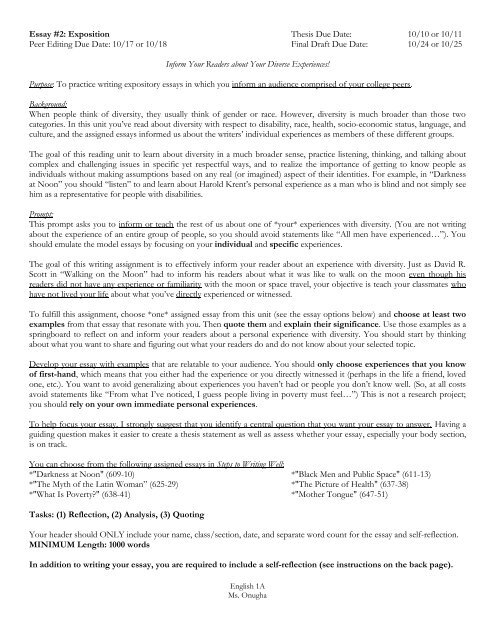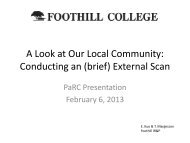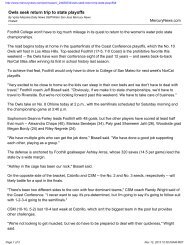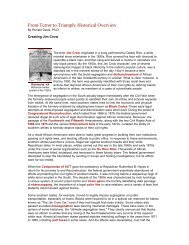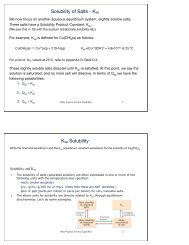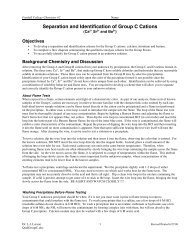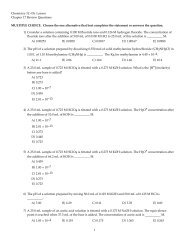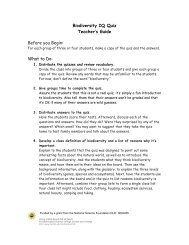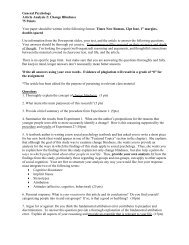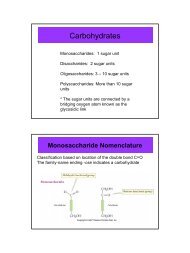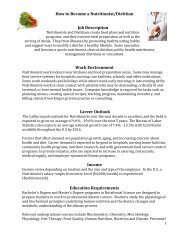Essay #1: Summary and Narration - Foothill College
Essay #1: Summary and Narration - Foothill College
Essay #1: Summary and Narration - Foothill College
Create successful ePaper yourself
Turn your PDF publications into a flip-book with our unique Google optimized e-Paper software.
<strong>Essay</strong> #2: Exposition Thesis Due Date: 10/10 or 10/11<br />
Peer Editing Due Date: 10/17 or 10/18 Final Draft Due Date: 10/24 or 10/25<br />
Inform Your Readers about Your Diverse Experiences!<br />
Purpose: To practice writing expository essays in which you inform an audience comprised of your college peers.<br />
Background:<br />
When people think of diversity, they usually think of gender or race. However, diversity is much broader than those two<br />
categories. In this unit you’ve read about diversity with respect to disability, race, health, socio-economic status, language, <strong>and</strong><br />
culture, <strong>and</strong> the assigned essays informed us about the writers’ individual experiences as members of these different groups.<br />
The goal of this reading unit to learn about diversity in a much broader sense, practice listening, thinking, <strong>and</strong> talking about<br />
complex <strong>and</strong> challenging issues in specific yet respectful ways, <strong>and</strong> to realize the importance of getting to know people as<br />
individuals without making assumptions based on any real (or imagined) aspect of their identities. For example, in “Darkness<br />
at Noon” you should “listen” to <strong>and</strong> learn about Harold Krent’s personal experience as a man who is blind <strong>and</strong> not simply see<br />
him as a representative for people with disabilities.<br />
Prompt:<br />
This prompt asks you to inform or teach the rest of us about one of *your* experiences with diversity. (You are not writing<br />
about the experience of an entire group of people, so you should avoid statements like “All men have experienced…”). You<br />
should emulate the model essays by focusing on your individual <strong>and</strong> specific experiences.<br />
The goal of this writing assignment is to effectively inform your reader about an experience with diversity. Just as David R.<br />
Scott in “Walking on the Moon” had to inform his readers about what it was like to walk on the moon even though his<br />
readers did not have any experience or familiarity with the moon or space travel, your objective is teach your classmates who<br />
have not lived your life about what you’ve directly experienced or witnessed.<br />
To fulfill this assignment, choose *one* assigned essay from this unit (see the essay options below) <strong>and</strong> choose at least two<br />
examples from that essay that resonate with you. Then quote them <strong>and</strong> explain their significance. Use those examples as a<br />
springboard to reflect on <strong>and</strong> inform your readers about a personal experience with diversity. You should start by thinking<br />
about what you want to share <strong>and</strong> figuring out what your readers do <strong>and</strong> do not know about your selected topic.<br />
Develop your essay with examples that are relatable to your audience. You should only choose experiences that you know<br />
of first-h<strong>and</strong>, which means that you either had the experience or you directly witnessed it (perhaps in the life a friend, loved<br />
one, etc.). You want to avoid generalizing about experiences you haven’t had or people you don’t know well. (So, at all costs<br />
avoid statements like “From what I’ve noticed, I guess people living in poverty must feel…”) This is not a research project;<br />
you should rely on your own immediate personal experiences.<br />
To help focus your essay, I strongly suggest that you identify a central question that you want your essay to answer. Having a<br />
guiding question makes it easier to create a thesis statement as well as assess whether your essay, especially your body section,<br />
is on track.<br />
You can choose from the following assigned essays in Steps to Writing Well:<br />
*"Darkness at Noon" (609-10) *"Black Men <strong>and</strong> Public Space" (611-13)<br />
*"The Myth of the Latin Woman” (625-29) *"The Picture of Health" (637-38)<br />
*"What Is Poverty?" (638-41) *"Mother Tongue" (647-51)<br />
Tasks: (1) Reflection, (2) Analysis, (3) Quoting<br />
Your header should ONLY include your name, class/section, date, <strong>and</strong> separate word count for the essay <strong>and</strong> self-reflection.<br />
MINIMUM Length: 1000 words<br />
In addition to writing your essay, you are required to include a self-reflection (see instructions on the back page).<br />
English 1A<br />
Ms. Onugha
To help you stay on track, please refer to the checklist below. It is NOT a prescription for how you must organize your essay<br />
or how many paragraphs you must include in your essay! It is simply a checklist designed to help you ensure that you include<br />
all of the elements that are necessary to successfully complete the assignment.<br />
I. Introduction: Provide your reader with essential background <strong>and</strong> contextual information. Your clear <strong>and</strong><br />
specific thesis (with opinion <strong>and</strong> blueprint of reasons) should come at the end of the<br />
introduction. (Your thesis should explicitly answer your central question.)<br />
II. Body Paragraphs: Your body paragraphs should fully develop <strong>and</strong> support the claims made in your thesis by<br />
providing sufficient examples. Your examples should support <strong>and</strong> clarify your thesis. They<br />
should also interest the reader <strong>and</strong> persuade your reader that your opinion is valid.<br />
III. Conclusion: Confidently reassert (with more detail) the claims put forth in the thesis statement by<br />
drawing upon the strength of your evidence (in this case your examples). This is also the<br />
time to introduce any larger points or conclusions you want to leave with your reader.<br />
SELF-REFLECTION INSTRUCTIONS<br />
(ATTACH TO THE END OF YOUR ESSAY)<br />
Write in complete sentences <strong>and</strong> paragraphs (not a list)<br />
Self-evaluation must be typed (carefully proofread)<br />
Write at least 250 words or your grade will be deducted automatically<br />
Place your self-evaluation at the end of your essay<br />
PLEASE TELL ME THE STORY OF HOW YOU WROTE YOUR ESSAY (in paragraph form)<br />
Don’t make a list. But be sure to include the following information in your answer:<br />
-- How long did you spend writing this essay? (Days? Weeks? Hours?)<br />
-- What steps did you take to write the essay? What did you do 1 st? 2 nd? 3 rd?<br />
-- Did you write a rough draft? Second draft? Third draft?<br />
-- Did you use any strategies from the textbook to help strengthen your essay?<br />
-- Did you seek help from other sources (Family? Friends? Tutors? Students?)<br />
-- What are the greatest strengths of your essay?<br />
-- What are the greatest weaknesses of your essay?<br />
-- What would you do differently next time?<br />
-- What steps did you take to improve your proofreading?<br />
English 1A<br />
Ms. Onugha


